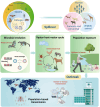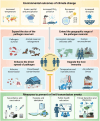Climate change, its impact on emerging infectious diseases and new technologies to combat the challenge
- PMID: 38767202
- PMCID: PMC11138229
- DOI: 10.1080/22221751.2024.2356143
Climate change, its impact on emerging infectious diseases and new technologies to combat the challenge
Abstract
ABSTRACTImproved sanitation, increased access to health care, and advances in preventive and clinical medicine have reduced the mortality and morbidity rates of several infectious diseases. However, recent outbreaks of several emerging infectious diseases (EIDs) have caused substantial mortality and morbidity, and the frequency of these outbreaks is likely to increase due to pathogen, environmental, and population effects driven by climate change. Extreme or persistent changes in temperature, precipitation, humidity, and air pollution associated with climate change can, for example, expand the size of EID reservoirs, increase host-pathogen and cross-species host contacts to promote transmission or spillover events, and degrade the overall health of susceptible host populations leading to new EID outbreaks. It is therefore vital to establish global strategies to track and model potential responses of candidate EIDs to project their future behaviour and guide research efforts on early detection and diagnosis technologies and vaccine development efforts for these targets. Multi-disciplinary collaborations are demanding to develop effective inter-continental surveillance and modelling platforms that employ artificial intelligence to mitigate climate change effects on EID outbreaks. In this review, we discuss how climate change has increased the risk of EIDs and describe novel approaches to improve surveillance of emerging pathogens that pose the risk for EID outbreaks, new and existing measures that could be used to contain or reduce the risk of future EID outbreaks, and new methods to improve EID tracking during further outbreaks to limit disease transmission.
Keywords: Emerging infectious disease; climate change; early diagnosis; outbreak; transmission.
Conflict of interest statement
No potential conflict of interest was reported by the author(s).
Figures




References
-
- 1918 Pandemic (H1N1 virus): Centers for Disease Control and Prevention; [cited 2024 Apr 30]. Available from: https://archive.cdc.gov/#/details?url=https://www.cdc.gov/flu/pandemic-r....
-
- WHO. 2023. Available from: https://covid19.who.int/.
-
- WHO. 2024. Available from: https://www.who.int/data/gho/data/themes/hiv-aids.
Publication types
MeSH terms
Grants and funding
LinkOut - more resources
Full Text Sources
Medical
